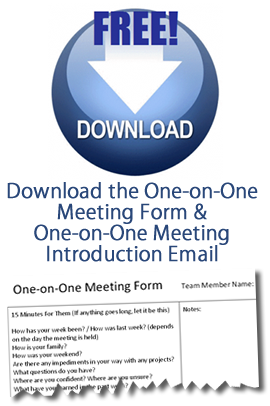I’ll go ahead and answer my own question in the title:
Yes! Of course you want to know my number one leadership tool.

I also won’t make you wait. The tool is one-on-one meetings.
Fellow blogger Jon Stolpe wrote about the power of one-on-one meetings and shares his experience below.
You can read all about how to run them, how not to run them, get free downloads and much more here:
One-on-One Meetings for Leaders
Here’s what Jon had to say…and stay tuned at the end of the post for an exciting announcement.
Do you feel connected to your team?
Several months ago, Matt encouraged his readers to establish and maintain weekly one-on-one meetings with their direct reports. At the time, I was contemplating what I could do to connect with my team on a deeper level.
As an operations manager in the construction industry, I’m challenged to balance my time as I’m responsible to make sure my group is operating as planned. I meet with my team members monthly on an individual basis to review their projects to review their projects from a financial, resource, risk, and customer perspective. These monthly meetings, which typically last about an hour, provide a pretty good snapshot of things from a business perspective, but they don’t provide a lot of time for diving deeper personally.
I’m also responsible for participating in other department and company meetings. Again, these meetings are important for certain aspects of our business success, but they typically don’t provide opportunity for connecting on a more personal level.
I’ve heard it said that “It’s business, it’s NOT personal.” Well, I disagree. As a Christian leader in the workforce, I have a responsibility (and privilege) to represent Christ well. For me, this means our relationships in the business world are meant to be personal.
How can we take time to connect with our team members with all the different demands on our time?
This is the question that rolled around in my head as I read Matt’s post. I have so many things on my plate already. One-on-one meetings just don’t fit into my already busy schedule.

But Matt challenged me with this question:
How can you NOT take time to connect with your team members?
And so…I took Matt’s challenge and encouragement to heart. I’ll confess, I haven’t followed Matt’s recipe exactly. Instead of weekly one-on-one
We talk about business and the challenges that they are facing on a project or assignment. And we also talk about life outside of work. I’ve learned about their interests, their passions, and their families.meetings, I started with monthly one-on-one meetings. For the most part, these meetings have been 30-40 minutes each. I use a one-page outline to guide our discussion and to take notes which helps me capture details of our discussion. With 12 direct reports, these notes have been essential to helping me remember our conversations. And it helps with my follow through on any action items that I have taken from our meeting. (NOTE: You can download a one-on-one meeting template here)
What difference does it make if you know your team members?
It makes all the difference in the world.
The average working person spends 9-10 hours of their days at work – every day. (That’s two-thirds or more of their waking hours). Most people work over 2100 hours every year. If my math is correct, most people work about 80,000 hours in their life time. However you do the math, we spend a lot of time at work.
We are relational beings. We are made to connect with others and to be in community with others.
We are missing a huge opportunity to connect with others if we go to work, come home, get our paycheck, but fail to connect with our co-workers.
Intentional connections
My one-on-one meetings have helped me be intentional in connecting with my team. It’s helped my team to feel more connected to me. And it’s also helped my team succeed from a business perspective.
I’m so thankful I listened to Matt and started having one-on-one meetings with my team.
From Matt…
Jon, I’m thankful you listened as well and honored that you placed my advice in such high regard.
And now for that exciting announcement…
OK, I actually have three and I can share two today. First, I will soon being work on my second book, which will be all about one-on-one meetings.
This is the second time that Jon has inspired me to do something big. The second announcement is that I have written a post for Jon which talks about the first time he did that. Look for it next month! In the meantime, go check out his blog now and learn more about Jon and his awesomeness. You can also connect with him on Twitter, Facebook or his blog.
Do you have one-on-one meetings with your team? If so, how have they made a difference? If not, what are you waiting for?
|
|
Questions?
Text me anytime at (260) 217-4619.
Or…check out some of my free reports to help you get on the right track:
 |
 |
 |
 |
 |
 |
 |
 |
 |







That’s my go-to tool too.
I assume you do them via Skype or GoToMeeting with HD Faces or something similar?
Gotta love technology!
Here’s my question. How do I approach my leaders about doing one to one meetings with me?
Ahhhh…a great question and something I am working on answering here. A few others have asked that as well.
If you can wait until I finish, great. If not, the short answer is:
Explain that you are requesting one-on-one time with them and why. Your why is important and should be something along the lines of that it will help you to understand him or her better, keep on track, and know how to think like your leaders better.
You want in their minds and odds are they want to let you in.
No need to mention that so-and-so recommended it (though I would love to have them as readers) or that you did it at your previous job, just that you want to know them better and this is a great way.
I would start off with specific purposes such as that. Bring up specific questions that you wrestle with and ask for guidance. Over time, the direction of the meetings will change.
Last piece: Ask for monthly at a set time to start with.
Great question. I think Matt answered it pretty well. I found that I needed one-on-one meetings with my manager more than ever after I started having them with my direct reports. Don’t back away from requesting this from your boss. It’s worth it!
I just don’t understand why people do not do them…actually I do know. They’re hard work, but how can you not do them?
I want to share a nice model I found conducting them – 70% for the employee, 20% for the boss, 10% for personal growth.
That is a great model Jim. I like to make them simple and go 10-10-10 for the half hour.
That is:
10 – team member
10 – me
10 – personal growth
But they usually look like 15-5-10
The one thing that CAN go over is the first 10. If there is something I definitely need to cover and need a full 10 minutes or more, I allot more time and let the other person know up front.
They are hard work initially, but I think they get a little easier as you do them consistently. I can tell that my team actually look forward to them. It’s their opportunity to get things off their chests and to get the help that they may not ask for otherwise. As leaders, we need to remember that we are here to help our teams succeed.
Great post, both of you, and thanks! Good work fires me up first thing in the morning.
I’ve decided that most people in leadership positions simply have no idea–NO idea–what leadership means, much less how to act it out on a daily basis. And when they hear a bit of what it’s about it scares them because it involves doing things they don’t understand, don’t know how to do, and put them at risk with their superiors.
As teachers, trainers, and leaders, we must have compassion on these poor souls and offer our wisdom (gained from tons of mistakes) to them. Then, they can either become the leaders their team needs them to be, or they can pursue other endeavors.
Leadership is not for everyone; not everyone is a leader.
“Leadership is not for everyone; not everyone is a leader.”
Amen to that. I am living proof that not everyone is a born leader, because it comes very unnaturally to me and I am still a long way from being even good.
Hmmm, I might argue that you have the instincts for good leadership, but you’ll know yourself better than I do.
Your blog posts show a ton of leadership wisdom that, natural or not, are a huge benefit to me!
I agree!
That means a lot Katherine. Thank you!
Thanks, Katherine. Leadership is definitely a process. The fact that you’re reading this is a sign that you care. We need to keep feeding our brains and keep learning (especially through our mistakes). We owe it to ourselves, to our direct reports, and to our companies.
Amen to all that, Jon, especially that we owe it to our direct reports and our companies to keep working to get better.
Sweet! I needed to read this this morning, a must re-read. Thanks Jon and Matt.
You’re welcome, Steve. Hope it helps. Make sure you head over to Matt’s post about establishing one-on-one meetings. It’s packed with a ton of information that will get you started.
I’ve struggled with this. I have 6 direct reports, and finding time for one-on-ones is tough. I need to get them scheduled!
Tom, I challenge you to do them.
Go here: https://www.mattmcwilliams.com/one-on-one-meetings-for-leaders/
There is a template for an email to send. Tweak it and send it.
Nike said it best…just do it!
Be intentional with putting them on your calendar. You can do it. And yes, it’s worth it!
Way to go Jon – great post, and congrats Matt on your announcements. I’ve been in environments where the one on one meetings were so infrequent, you automatically assumed something was wrong when you had one. The most effective teams I’ve had were when I had regular meetings with each person. Great advice!
Thanks, Carol. It has definitely helped my team.
Matt, I just scheduled a post for Wed (10/23/2013) that mentions this post. My post on Wed. will talk about ways to enhance the performance management process. I hope you’ll check it out (and even point your readers my way). I think it’s something that will resonate with your readers.
That’s awesome Jon!
P.S. Can you remind me via email Wednesday? 🙂 Just in case.
Just sent you an e-mail. Here’s the link: http://www.jonstolpe.com/2013/10/23/10-essentials-for-enhancing-the-performance-management-process/